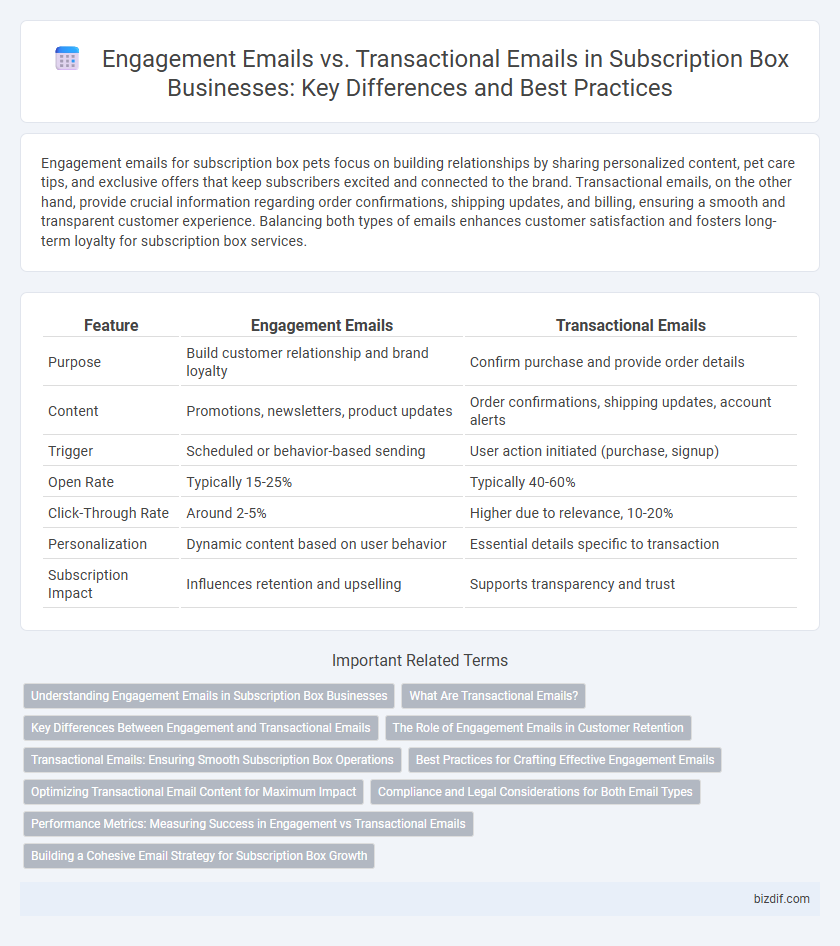Engagement emails for subscription box pets focus on building relationships by sharing personalized content, pet care tips, and exclusive offers that keep subscribers excited and connected to the brand. Transactional emails, on the other hand, provide crucial information regarding order confirmations, shipping updates, and billing, ensuring a smooth and transparent customer experience. Balancing both types of emails enhances customer satisfaction and fosters long-term loyalty for subscription box services.
Table of Comparison
| Feature | Engagement Emails | Transactional Emails |
|---|---|---|
| Purpose | Build customer relationship and brand loyalty | Confirm purchase and provide order details |
| Content | Promotions, newsletters, product updates | Order confirmations, shipping updates, account alerts |
| Trigger | Scheduled or behavior-based sending | User action initiated (purchase, signup) |
| Open Rate | Typically 15-25% | Typically 40-60% |
| Click-Through Rate | Around 2-5% | Higher due to relevance, 10-20% |
| Personalization | Dynamic content based on user behavior | Essential details specific to transaction |
| Subscription Impact | Influences retention and upselling | Supports transparency and trust |
Understanding Engagement Emails in Subscription Box Businesses
Engagement emails in subscription box businesses drive customer interaction by delivering personalized content, exclusive offers, and timely updates that nurture loyalty and reduce churn. These emails often include product recommendations, sneak peeks of upcoming boxes, and feedback requests, which enhance the customer's connection to the brand. Unlike transactional emails that confirm actions like purchases or shipments, engagement emails focus on building long-term relationships and increasing customer lifetime value.
What Are Transactional Emails?
Transactional emails are automated messages triggered by specific user actions within a subscription box service, such as order confirmations, shipping notifications, and password resets. These emails provide essential information directly related to a customer's transaction, ensuring clarity and trust throughout the purchase process. Unlike engagement emails designed to promote products or encourage re-subscription, transactional emails focus on delivering timely, relevant updates to enhance the user experience.
Key Differences Between Engagement and Transactional Emails
Engagement emails aim to build customer relationships by encouraging interaction and increasing brand loyalty, featuring content like promotions, newsletters, and product updates. Transactional emails, triggered by specific user actions, provide essential information such as order confirmations, shipping updates, and password resets. Key differences include their purpose--engagement emails focus on marketing and retention, while transactional emails serve functional communication--and their regulatory requirements, with transactional emails often having higher delivery priority and less strict opt-in necessities.
The Role of Engagement Emails in Customer Retention
Engagement emails play a critical role in customer retention by fostering ongoing interaction and building brand loyalty beyond the initial purchase experience in subscription box services. These emails typically include personalized content, special offers, and updates that keep subscribers interested and invested in the subscription. Unlike transactional emails that confirm purchases or shipments, engagement emails nurture a long-term relationship, increasing the likelihood of subscription renewals and customer lifetime value.
Transactional Emails: Ensuring Smooth Subscription Box Operations
Transactional emails are critical for subscription box services, as they ensure seamless communication regarding order confirmations, shipping updates, and payment receipts. These emails enhance customer experience by providing timely, relevant information that reduces confusion and builds trust. Automating transactional emails optimizes operational efficiency and supports consistent subscriber engagement throughout the subscription lifecycle.
Best Practices for Crafting Effective Engagement Emails
Effective engagement emails for subscription boxes prioritize personalized content that resonates with the subscriber's preferences and past behavior, driving higher open and click-through rates. Incorporate compelling subject lines, clear calls-to-action, and visually appealing designs to maintain subscriber interest and encourage ongoing interaction. Consistent segmentation and A/B testing help optimize message relevance, boosting customer retention and lifetime value.
Optimizing Transactional Email Content for Maximum Impact
Optimizing transactional email content in subscription boxes involves personalizing order confirmations, shipping updates, and renewal reminders to enhance customer engagement and build brand loyalty. Including clear calls-to-action, relevant product recommendations, and concise, informative content increases customer retention and drives repeat purchases. Leveraging dynamic content and responsive design ensures emails are visually appealing and functional across all devices, maximizing impact.
Compliance and Legal Considerations for Both Email Types
Engagement emails and transactional emails in subscription box services must comply with regulations such as the CAN-SPAM Act and GDPR, ensuring clear consent, easy opt-out options, and accurate sender identification. Transactional emails, which convey essential order or account information, often have more lenient consent requirements but still require strict adherence to privacy and data protection laws. Engagement emails designed for marketing purposes demand explicit user consent and transparent data usage policies to maintain legal compliance and protect subscriber trust.
Performance Metrics: Measuring Success in Engagement vs Transactional Emails
Engagement emails show higher open rates, averaging 20-30%, driven by personalized content and targeted calls-to-action that boost click-through rates up to 15%. Transactional emails, crucial for order confirmations and shipping updates, exhibit open rates exceeding 70% due to their time-sensitive nature, with click-through rates typically around 10%. Measuring success involves tracking conversion rates, customer retention, and revenue impact, where engagement emails foster long-term loyalty while transactional emails ensure immediate customer satisfaction and trust.
Building a Cohesive Email Strategy for Subscription Box Growth
Engagement emails nurture subscriber relationships by delivering personalized content, exclusive offers, and valuable updates that drive brand loyalty and repeat purchases. Transactional emails, such as order confirmations and shipping notifications, provide essential information and enhance customer trust while offering opportunities for subtle upselling and cross-selling. Combining these email types in a cohesive strategy maximizes subscriber retention and boosts subscription box growth through consistent communication tailored to the customer journey.
Engagement emails vs Transactional emails Infographic

 bizdif.com
bizdif.com